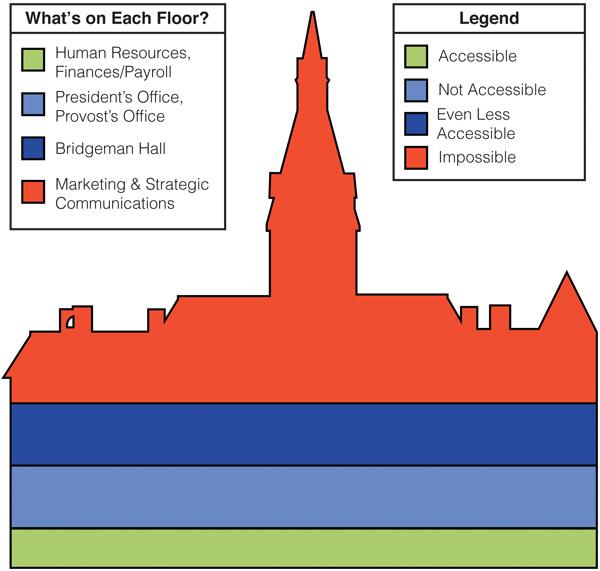Accessing Hamline; how easy is it?
How does Hamline assist students with mobility issues?
October 26, 2015
There are several issues currently regarding the physical accessibility of Hamline University’s campus. Some of the difficulties for students with mobility issues are malfunctions with elevators and handicap buttons or buildings that don’t have ramps, elevators or handicap buttons.
One issue is the new, public elevator in the Bush Center. It works wonders; however, the elevator is blocked by a non-automatic door. As a result, students trying to get to the Disability Resources office are forced to use the elevator in Walker.
Some buildings that are troublesome for students with mobility problems are Old Main, the Admissions House and Manor Residential Hall- all buildings without elevator access to all floors.
“Are we fully accessible? No. Are we working on it? Yes. Hamline is a great school, and I want everyone to access it,” said Steve Anderson, Director of Disability Resources. Anderson oversees the department and provides accommodations for Hamline students throughout the classroom, residential buildings and everywhere in between.
“Our physical accessibility could use some work because of our old campus, but Hamline is working on making our school accessible to all students,” Anderson said.
Anderson believes Hamline’s accessibility is “a work in progress,” especially when trying to find the balance between being reactive to specific situations and proactive to general issues.
“Students can always ask for help, but places should be accessible without needing help,” Anderson said.
The Facilities department’s mission is to make Hamline accessible to all.
“We have been responsive to the concerns of individual students, as well as working with Disability Services very closely,” said Ken Dehkes, Director of Facilities Operations.
Facilities has worked to install a Limited Use Limited Accessibility (LULA) elevator in Drew Fine Arts, since many classes held in that building are “specialty” classes that can’t easily be moved to a more accessible building.
They also work with the scheduling office during the winter. They clear snow for students with physical disabilities in certain areas, that need to use an area of campus, at a certain time. Facilities has installed visual as well as auditory alarms in all on-campus buildings. They are also working to meet the needs of students living in the apartments who need doors or furniture modified.
Ken Dehkes and Lowell Bromander, both from Facilities, were interviewed about Hamline’s response to physical accessibility issues and what tangible changes have been made over the years in order to become a safer and more equitable campus.
They both spoke of the difficulties in renovating Hamline’s buildings, many of which were built across different timeframes. Many buildings were constructed before the Americans with Disabilities Act was passed in 1990. This law prohibits discrimination based on ability and requires employers to provide reasonable accommodations to people with disabilities and implement accessibility requirements on public accommodations.
For example, Old Main is on the National Register of Historic Places, which according to Dehkes makes any physical changes to the building very difficult and time-consuming. Drew Residence Hall was built across three different time periods, and the building itself “doesn’t quite line up internally,” said Dehkes.
During renovations, Hamline works to integrate accessibility with aesthetics. When a request is made to modify furniture, to add an elevator or for bathrooms to be updated the Facilities office works with the architect who designed the building.
This creates a more cohesive look, but it also becomes necessary to consult with architects because they are experts on construction laws and regulations, like the Americans with Disabilities Act.
It’s not as simple as it sounds. For example, if a larger stall needed to be added to a bathroom, the total number of stalls would decrease. Which would violate each building’s occupant level of how many toilets the building must contain. Tricky problems like this are why the architects are brought on board whenever possible.
“We continue to work to make an accessible campus every year, with every project,” said Lowell Bromander, Associate VP of Facilities.
Disability Resources is a strong resource for students who need accommodations. Tayler Johnson, a student worker in Disability Resources, expressed her thoughts on the physical accessibility of our campus.
Johnson said the limitations on campus “cause stress and increase anxiety” for students who have mobility issues. “It affects them when they need to get to class on time and take exams… We need to provide what’s best for the students,” Johnson said.
Several ideas have been brought up in both Facilities and Disability Resources, such as heated sidewalks to implement a safer environment for students who use wheelchairs or crutches.
Another idea is providing lower and more accessible computer stations at the computer bar in the Anderson Center.
“Everyone can use these accommodations,” Anderson said. “Not just people with disabilities.”

